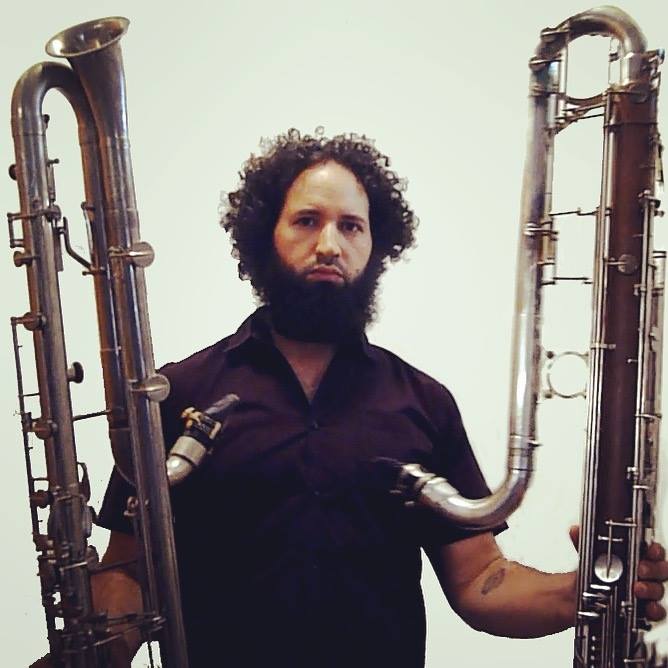I am currently undertaking PhD research at the Royal Northern College of Music in Manchester, UK, expected to submit in 2020. The topic of this research is:
A New Collaborative Approach Between Composer and Performer Towards the Creation of a Compendium of Contrabass Clarinet Sonic Possibilities.
My aim is to create the first comprehensive compendium of the contrabass clarinet, utilizing an original method of composer-performer collaboration to discover the sonic possibilities of the instrument. My objectives include creating a resource for both performers and composers highlighting, demonstrating, and explaining extended techniques on and contemporary use of the three most-used professional “low-C” contrabass clarinets- Leblanc, Selmer, and Eppelsheim.
The resource will focus on the production of multiphonic and quarter-tone fingering charts applicable for all three instruments, but explore and build on other extended techniques already used within the clarinet family through my own playing, researching other contrabass clarinetists, and collaboration with composers. The compilation of these fingering charts and techniques will be collected into a resource and published in print and online, accompanied by audio and video demonstrations. The resource will be used with composers to collaborate on new works for the instrument that will utilize the charts and techniques, in both solo and ensembles settings. These pieces will be given public performances and recorded.
The need for this research has emerged from my collaborations with composers on new works for the contrabass clarinet. I am a well-respected clarinetist with an active international performing career, specializing in bass clarinet, contemporary music and improvisation, and have also been playing the contrabass clarinet for over 20 years, including on commercial recordings. My education comes from the lineage of Harry Sparnaay, the pioneer of the bass clarinet as a solo and contemporary instrument, and also a contrabass clarinetist. I regularly commission new pieces and work in close collaboration with the composers during the writing process, and to date have premiered 36 pieces as a soloist or part of an ensemble. My quarter-tone fingering charts are the most detailed available for both clarinet and bass clarinet, and have been cited as a resource in doctoral dissertations in Europe, the US, and Australia, and are currently being used by leading clarinetists, composers, and pedagogues, including Eric Mandat at Southern Illinois University and Jun Qian at Baylor University. I am very active in both the International and European Clarinet Associations, regularly perform at their festivals, and am also the editor of The Clarinet Online. I have a large network of fellow contrabass clarinetists and composers to work and collaborate with, and will have access to all the information and instruments necessary for the completion of my research.
Currently there are three main makes of contrabass clarinets being used professionally- Selmer, Leblanc, and Eppelsheim. All three have very different designs, keywork, and capabilities. Performers choose, and are frequently limited as to which instrument they can play, for different reasons, such as which instrument is available to them through their ensemble, educational institution, or local rental supplier.
The lack of standardization between models has posed a problem when commissioning new works, as it is naturally desirable to both composers and performers for a piece to be playable regardless of instrument make. However, when it comes to writing music using contemporary and extended techniques, particularly multiphonics, altissimo and quarter-tone fingerings, many aspects are non-transferrable between instruments due to design differences. In particular, I will observe the similarities and differences between instruments, so fingering charts will reflect this, and have model-specific alternate fingerings where possible. If a particular technique found through the collaborative process works on one instrument but not another, I will research ways to achieve the same result, but impossibilities will also be noted. The composer-performer collaboration will thus continue to drive the research and exploration of the capabilities of the instruments.
There is a pressing need for research into this area as there has been very little information published in this field for the contrabass clarinet. In terms of existing research, Terje Lerstad published altissimo register fingering charts in The Clarinet in 1991, and Heather Roche published twenty-six multiphonic fingerings for the Leblanc instrument on her blog in 2015. Theo Nabicht also has a video demonstrating some extended techniques on a Selmer instrument, but none of it has been notated. The Eppelsheim is still a rather new development and has made significant changes to the instrument’s keywork yielding many new possibilities, but to my knowledge none of it has been formally studied yet. These are all starting points, but there is still a wealth of information yet to be researched and no single resource to which composers and performers can refer.
My research will be rooted firmly in both performance and musicology. I will create a printed and online resource building on existing published comprehensive methodologies for clarinet and bass clarinet, such as Rehfeldt's New Directions for Clarinet and Sparnaay’s The Bass Clarinet, which cover a range of extended techniques for clarinet and bass clarinet, but it would require more detailed fingering charts, such as Watts' Spectral Immersions for bass clarinet multiphonics and Farmer's Multiphonics and Other Contemporary Clarinet Techniques which includes multiphonic tremolo fingering charts. I will also include extended-range quarter-tone fingering charts modeled on those I have already published for clarinet and bass clarinet.
5-1/2 octave chromatic scale on a Leblanc "Paperclip" contrabass clarinet! Written C3-F8 (sounding Bb0-Eb6)
5-1/2 octave chromatic scale on a Selmer contrabass clarinet! Written C3-F8 (sounding Bb0-Eb6)
5-1/2 octave chromatic scale on an Eppelsheim contrabass clarinet! Written C3-F8 (sounding Bb0-Eb6)
5-1/2 octave chromatic scale on all 3 contrabsas clarinets at once! Written C3-F8 (sounding Bb0-Eb6)
Stay Tuned for more developments in the research!




